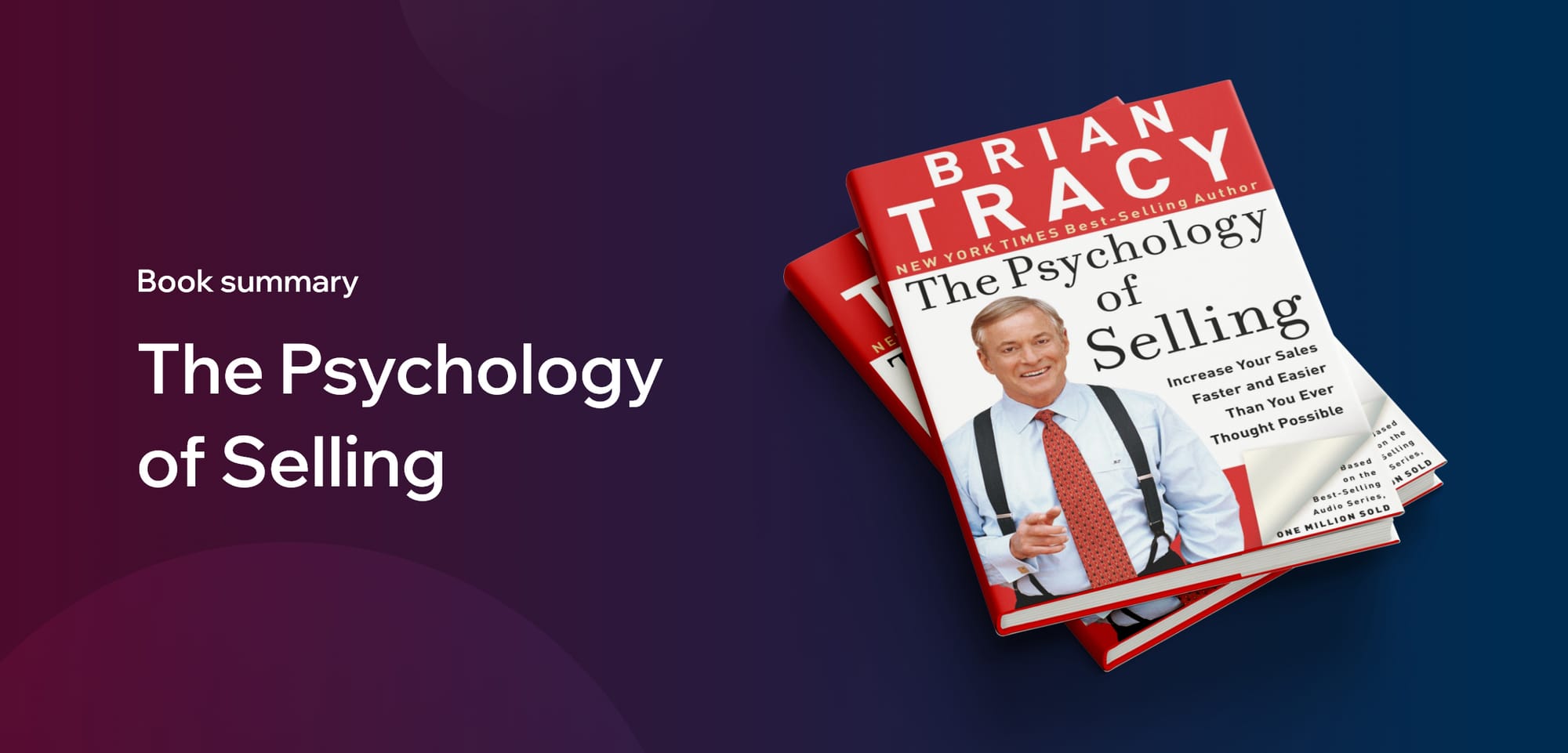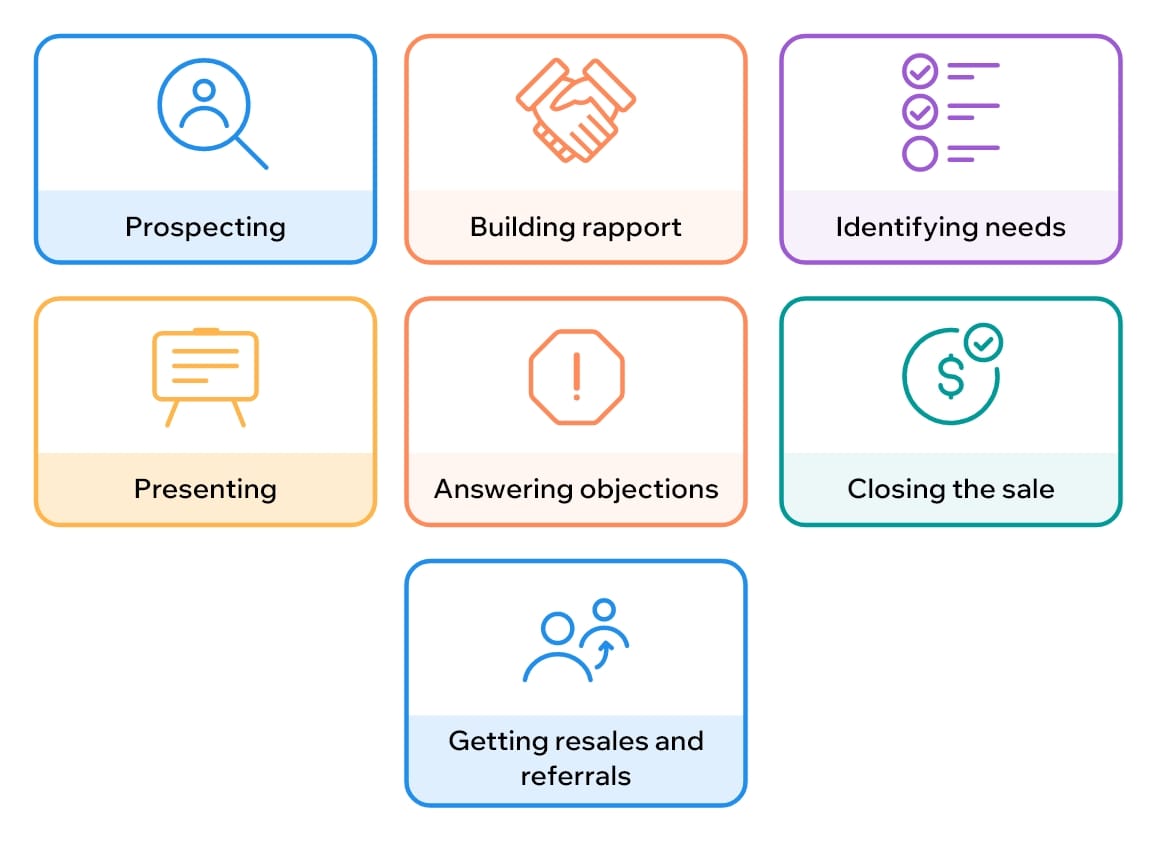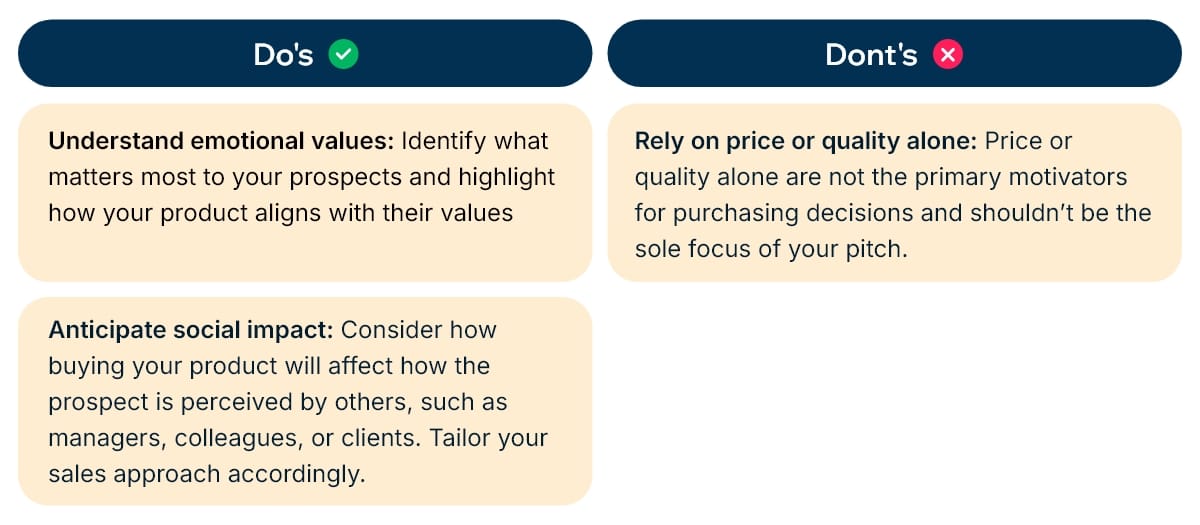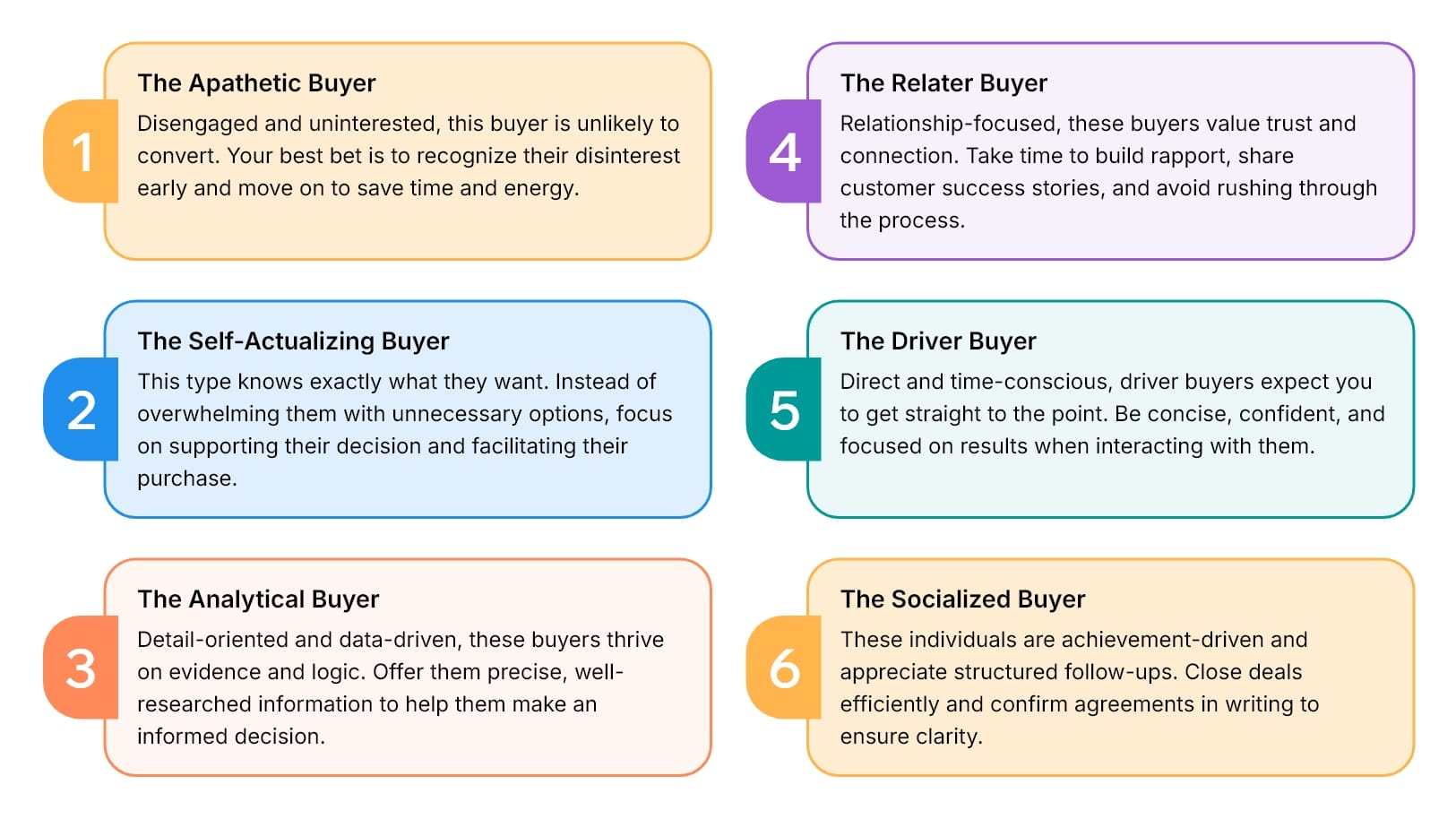The Psychology of Selling: Strategies, tips, & cheatsheet
Discover the sales strategies and psychological insights from Brian Tracy’s The Psychology of Selling. This blog provides actionable tips, sales frameworks, and creative techniques.

Sales is more than a transactional process—it's a nuanced art of human connection and strategic communication.
Brian Tracy's The Psychology of Selling offers a deep dive into this dynamic interplay, going beyond traditional sales techniques to explore the psychological and emotional factors that influence buying decisions.
Since its release in 1988, this enduring classic has remained a cornerstone for sales professionals at every level, from beginners to industry veterans.
In this blog, we’ll explore the invaluable strategies and actionable insights from Tracy’s work, unlocking the keys to elevating your sales game to new heights.
Chapter 01: The inner game of selling
Brian Tracy’s The Psychology of Selling opens with a powerful truth: sales success begins in the mind. The book highlights a transformative idea: a salesperson's self-concept—the way they perceive their abilities and potential—is the ultimate driver of their performance.
One of the standout ideas Tracy introduces is the 80/20 rule (also known as Pareto principle), which reveals that a mere 20% of salespeople are responsible for generating the majority of results. This observation serves as both a challenge and an opportunity: how can a salesperson join this elite group? Tracy’s answer lies in the winning edge concept.
The winning edge concept
According to this concept, instead of focusing on massive overnight changes, sales professionals should master the fundamentals with precision and persistence.
To help salespeople develop their winning edge, Tracy outlines 7 key result areas (KRAs) that demand focus and mastery.

- Prospecting: Finding and qualifying potential customers.
- Building rapport: Establishing trust and connection with prospects.
- Identifying needs: Uncovering the true challenges or desires of the customer.
- Presenting: Delivering compelling, tailored solutions.
- Answering objections: Addressing concerns confidently and effectively.
- Closing the sale: Guiding prospects to make a commitment.
- Getting resales and referrals: Strengthening relationships for future business and recommendations.
Mastering these areas, Brian Tracy asserts, is not just about learning techniques but also about developing the right mindset. This is where the self-concept becomes crucial.
The role of self-concept and the financial thermostat
At the heart of sales performance is self-concept, the internal beliefs about one’s abilities and potential. Tracy argues that these beliefs profoundly influence a salesperson's actions and results. A key idea he introduces is the "financial thermostat," which reflects how an individual’s perceived earning potential limits their income. For example, if someone believes they are only capable of earning $50,000 annually, their actions will subconsciously align with that figure. By challenging these self-imposed limitations and resetting this thermostat, salespeople can unlock higher earning potential.
Mastering inner dialogue
One of Tracy’s most empowering insights is the importance of controlling inner dialogue. Successful salespeople replace negative, self-doubting thoughts with affirmations of confidence and success. This practice not only fosters resilience but also reinforces the behaviors that drive exceptional performance.
A blueprint for sales excellence
Through these transformative concepts, The Psychology of Selling serves as a blueprint for sales professionals aiming to rise to the top. By cultivating the right mindset, mastering core skills, and embracing incremental improvement, anyone can join the top 20% and achieve extraordinary results.
Brian Tracy says, “successful people control their inner dialogues.”
Chapter 02: Setting and achieving sales goals
In his work, Brian Tracy highlights the psychology of selling by providing a link between achieving sales success and setting clear, well-structured goals. He advocates for the use of the SMART framework (Specific, Measurable, Achievable, Relevant, and Time-bound) as a way to keep sales professionals focused, organised, and motivated. By breaking large ambitions into smaller, actionable steps, Tracy believes salespeople can systematically move toward their desired outcomes while maintaining momentum.
Structuring sales goals
Tracy provides a practical roadmap for setting and managing sales goals:
- Set annual income goals: Identify your desired income, using past earnings as a base, and target a 25–50% increase to encourage growth.
- Determine annual sales targets: Calculate how much product/service you need to sell to meet income goals.
- Break down goals: Divide annual targets into manageable monthly, weekly, and daily benchmarks for easier tracking and adjustments.
- Focus on activities: Track key actions like calls, emails, and meetings to refine your approach and improve outcomes.
- Tie goals to personal aspirations: Connect sales objectives to personal motivations, like funding education or achieving financial independence, for deeper purpose.

The power of visualisation
One of Tracy’s standout strategies is the idea of writing down 100 goals for the future, covering everything from career ambitions to personal dreams. This exercise helps salespeople dream big while keeping track of smaller milestones along the way. Visualisation plays a key role in this process. By vividly imagining a prospect enthusiastically responding to your pitch or envisioning the rewards of a successful quarter, you cultivate a sense of excitement and positivity. This mental rehearsal not only builds confidence but can also influence your behavior, making you more persuasive and optimistic during real-world interactions.
Chapter 03: Why do people buy?
Primary motivators for buying
Understanding the underlying reasons why people buy is key to becoming an effective salesperson. Brian Tracy explains that every purchase is driven by a desire to fulfill basic human needs. These motivators include:
- Financial security: The need for stability and assurance about the future.
- Safety and peace of mind: A sense of protection, whether physical or emotional.
- Recognition and social acceptance: Feeling valued and included within a social context.
- Status and prestige: Elevating one’s position in the eyes of others.
- Health and well-being: Prioritising physical and mental health.
- Love and companionship: Building meaningful connections with others.
- Personal growth and self-improvement: Achieving progress and self-fulfillment.
When people make purchases, they aren’t just buying a product or service—they’re buying the emotional and practical benefits it provides. A luxury car, for instance, isn’t just a mode of transportation; it symbolises status and success. Similarly, a home security system isn’t just equipment; it represents peace of mind.
Selling to human motivations
At the heart of every purchase lies a desire for improvement. People buy because they believe your product or service will make their lives better. Tracy emphasises that to effectively influence buying decisions, sales professionals must understand not only what their prospects need but also why they need it—and how their solution fulfills those needs better than competitors.

The dual drivers: Gain vs. fear of loss
Tracy pinpoints two primary drivers behind buying decisions: the desire for gain and the fear of loss. While both are critical, fear often holds more sway.
This knowledge is a powerful tool for crafting persuasive sales messages. For instance:
- Desire for gain: “This software will boost your team’s productivity by 30%, making your job easier and more efficient.”
- Fear of loss: “Without this solution, you risk falling behind competitors who are already seeing results from adopting similar tools.”
Brian Tracy’s insights are a reminder that selling isn’t about the product—it’s about the person buying it. Effective sales professionals recognize that emotions drive decisions, even in seemingly rational contexts like B2B sales. For instance, a business executive may choose your software not just for its features but because it ensures they look competent to their peers and secures their job.
The real art lies in uncovering the specific emotional triggers for your prospects and addressing both their aspirations and anxieties. By doing this, you position your product as the ultimate solution that not only meets their practical needs but also satisfies their deeper, human motivations.
Chapter 04: Concept of creative selling
Brian Tracy explores the powerful link between creativity and success in sales.
Creativity isn’t reserved for artists or innovators—it’s a skill tied to your self-concept and can be cultivated through deliberate practice.
If you’ve ever improvised your way through unexpected challenges, like rerouting during a traffic jam, you’ve already tapped into the kind of creative problem-solving that’s invaluable in sales.
The ability to think creatively allows salespeople to adapt during prospect calls and presentations, navigating surprises with confidence. Tracy suggests building this skill by focusing on specific strategies:
- Set clear goals: Define your objectives to sharpen focus and inspire creative solutions.
- Tackle pressing problems: Challenges often spark innovative thinking.
- Ask focused questions: Specific inquiries lead to actionable insights.
Creative thinking in prospecting
Creativity shines during prospecting, helping salespeople uncover buying motives and position their offerings effectively. Tracy suggests asking targeted questions, such as:
- What are the most compelling features of my product?
- What customer needs does my product address?
- How does my company stand out from competitors?
These questions clarify your value proposition and deepen your connection with prospects by addressing their specific needs.
Four key areas to excel in selling
To elevate your sales strategy, Tracy identifies four areas that demand focus:
- Specialisation: Develop expertise in your product’s unique benefits to build trust and authority.
- Differentiation: Clearly communicate what makes your product superior.
- Segmentation: Focus on the customer segments most likely to benefit from your product.
- Concentration: Prioritize high-potential prospects to maximize efficiency and results.
Boosting creativity through brainstorming
Regular brainstorming sharpens creativity and problem-solving. Tracy suggests generating 250 ideas annually—an ambitious yet transformative practice that builds innovative thinking over time.
By combining creativity with strategic focus, salespeople can adapt to challenges, uncover deeper customer needs, and ultimately achieve greater success.
Chapter 05: Getting more appointments
Success in sales isn’t about chasing every lead—it’s about focusing on the right prospects. This is where sales prospecting services can make a big difference, helping sales teams zero in on high-quality leads and book more effective meetings.
On hte other hand, here’s how to make each interaction count:
1. Break through the noise
First impressions matter. With busy prospects, a straightforward opener like, “I need two minutes of your time. Is this a good time to talk?” captures attention while showing respect for their time. This approach establishes professionalism and sets the stage for a productive conversation. If they agree, you’ve got their focus. If not, you avoid wasting time on someone who isn’t available or interested.
2. Sell the appointment, not the product
Avoid overwhelming prospects with product details too early. Instead, focus on securing the next step, like scheduling a meeting or demo. This shifts the emphasis from selling to exploring value, reducing pressure and increasing their willingness to engage.
This strategy shifts the focus from “selling” to “exploring value,” making the prospect feel less pressured and more willing to engage.
3. Use words that resonate
Tailor your message to the prospect’s needs and outcomes. Rather than describing features, emphasize benefits:
- Instead of: “We offer software for streamlining operations.”
- Say: “We’ve helped companies like yours reduce overhead by 30%.”
This approach addresses pain points and desired results, making your pitch more compelling.
4. Handle objections with confidence
When faced with, “I’m not interested,” don’t back down—it’s often a reflex, not a rejection. Reframe the conversation with social proof:
- “That’s alright. Many in your industry felt the same at first, but now they’re some of our best clients and even recommend us to others.”
This technique works because it introduces social proof—evidence that others in similar situations found value in your offering—and positions you as a potential ally rather than a pushy salesperson.

Chapter 06: The power of suggestion
Our surroundings and demeanor significantly shape how others perceive us, particularly in professional settings. A salesperson who exudes confidence, composure, and competence naturally earns greater trust and credibility. Brian Tracy provides actionable strategies to elevate your persuasive skills by refining your professionalism and creating value.
1. Dress professionally
Your attire speaks before you do. Dressing appropriately for your industry and audience shows respect and signals confidence. It’s not about being flashy but aligning your appearance with professional expectations to establish authority.
2. Rehearse your presentation
Preparation fosters confidence. A well-rehearsed pitch allows you to deliver your message clearly, anticipate objections, and polish your delivery. Practice ensures you enter meetings with clarity and conviction. To enhance your presentation, you can format slides with AI to streamline design and ensure a professional, visually compelling pitch.
3. Optimise your workspace
A tidy, organised workspace reflects professionalism and enhances focus. Whether in-person or virtual, maintaining a distraction-free environment leaves a positive impression on clients and colleagues.
4. Boost your productivity
Being prepared and efficient reduces stress and allows you to focus fully on your audience. Organize your materials and stay proactive to project calmness and readiness.
5. Use positive body language
Nonverbal cues strengthen your message. Maintain eye contact, sit upright, and use open gestures to convey attentiveness and sincerity. Minimize distractions and ensure your body language aligns with your words.
Creating value through presence
Persuasion is about building trust and demonstrating value. Show your audience their time matters by:
- Listening actively: Understand their needs and concerns.
- Responding thoughtfully: Address their specific challenges.
- Tailoring your message: Align your solutions with their unique priorities.
By consistently applying these strategies, you’ll project credibility, foster engagement, and build authentic connections. Persuasion is not about manipulation—it’s about guiding others toward solutions that benefit everyone involved.
Chapter 07: Making the sale
First impressions and buyer types
The first moments of a sales conversation are crucial—they determine whether your prospect will engage with you or resist your pitch. Brian Tracy emphasizes that most people naturally put up "sales resistance" as a protective mechanism. Rather than battling this resistance, the key is to acknowledge and work with it. Tracy offers two practical strategies for opening a conversation:
- The approach close: Reduce pressure with a reassuring statement like: “Relax, I’m not trying to sell you anything right now. I just ask you to look at this with an open mind and decide if it makes sense for your situation.” This sets a friendly, non-coercive tone that encourages engagement.
- The demonstration close: Gauge the prospect’s readiness with a direct question: “If I show you the best [product/service] available today, are you in a position to invest [price] right now?” This approach identifies qualified leads, ensuring you focus on high-potential prospects.
Both strategies work because they reduce initial resistance, giving you the opportunity to build rapport and establish trust.
Understanding buyer personalities
Not all buyers are created equal. Tracy categorises them into six distinct types, each requiring a tailored approach for successful engagement:

- 1. Analytical buyers: Value data and reliability.Strategy: Provide detailed specifications and case studies.
- 2. Relater buyers: Focus on relationships and shared values.Strategy: Share customer satisfaction stories and emphasize trust.
- 3. Driver buyers: Prioritize efficiency and results.Strategy: Highlight time savings and performance benefits.
- 4. Amiable buyers: Seek harmony and reassurance.Strategy: Present solutions in a calm, supportive manner.
- 5. Expressive buyers: Crave recognition and excitement.Strategy: Showcase innovative features and personal impact.
- 6. Skeptical buyers: Demand evidence and persuasion.Strategy: Address objections with testimonials and solid proof.
Personalising your sales approach
Customizing your approach based on the buyer's personality fosters meaningful connections and better outcomes.
- Listen actively: Understand their unique needs and concerns.
- Ask open-ended questions: Encourage dialogue and uncover deeper motivations.
- Pause thoughtfully: Show you value their perspective.
For instance:
- With an analytical buyer, emphasize data and reliability.
- With a relater buyer, focus on shared experiences and trust-building.
By combining these strategies, you can overcome resistance, engage prospects effectively, and build lasting relationships.
Chapter 08: The 10 keys to success in selling
Brian Tracy outlines ten enduring principles that transcend sales techniques, focusing on the mindset and habits of top performers. Here’s a breakdown of these principles:
- Pursue work you are passionate about: Passion fuels enthusiasm and resilience. When you genuinely believe in what you’re selling, your energy is contagious, making it easier to overcome challenges.
- Set clear goals and focus on them: Clear goals provide direction and purpose. By aligning daily actions with long-term aspirations, successful salespeople maintain focus and drive.
- Stay persistent and determined: Rejections are part of sales, but persistence separates top performers from the rest. Consistent effort and determination lead to breakthroughs.
- Commit to continuous learning: The sales landscape evolves constantly. Lifelong learning ensures you stay ahead of trends, master new tools, and refine your techniques.
- Manage your time effectively: Time is your most valuable resource. Prioritize high-impact activities like nurturing relationships and closing deals to maximize results.
- Learn from successful role models: Observing successful salespeople accelerates growth. Seek mentors who inspire and guide you, adopting their habits and strategies.
- Build and uphold strong character: Integrity, honesty, and reliability are essential. Trust forms the foundation of lasting client relationships and sustainable success.
- Tap into your natural creativity: Creativity in sales means finding innovative ways to connect, solve problems, and close deals. Think outside the box to stand out.
- Treat others as you wish to be treated: Respect, empathy, and genuine care for clients foster loyalty and referrals. Positive interactions create lasting impressions.
- Commit to effort and dedication: Success in sales isn’t automatic—it’s earned. Hard work, dedication, and a willingness to go the extra mile are key to meaningful achievements.
Conclusion: Unlocking sales success through mindset and strategy
Brian Tracy's The Psychology of Selling serves as a comprehensive guide to mastering both the art and science of sales. At its core, the book reminds us that success stems not only from strategies and techniques but also from cultivating the right mindset, staying committed to growth, and genuinely understanding the human motivations behind every purchase decision.
From mastering the game of selling and setting actionable goals to leveraging creativity and building meaningful client relationships, Tracy’s principles offer a clear path for aspiring and seasoned salespeople alike.
In the ever-evolving landscape of sales, these timeless lessons remain as relevant as ever. As you apply these strategies, tips, and techniques to your unique sales challenges, remember that success is built incrementally, one confident step at a time.






